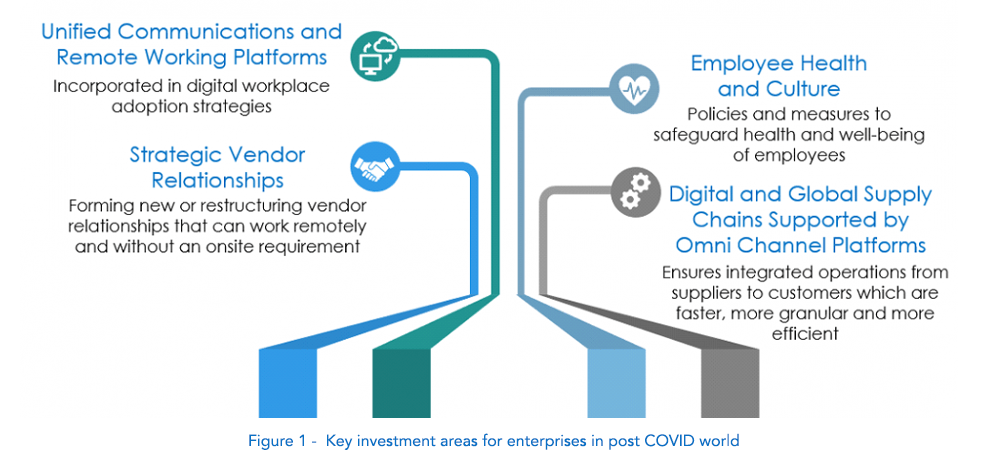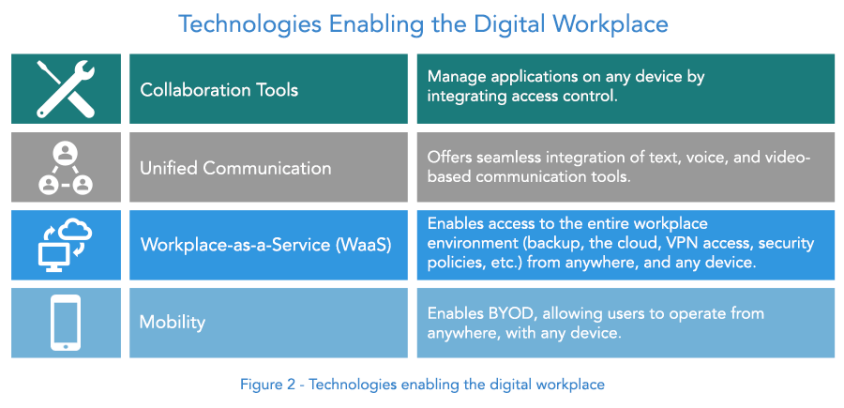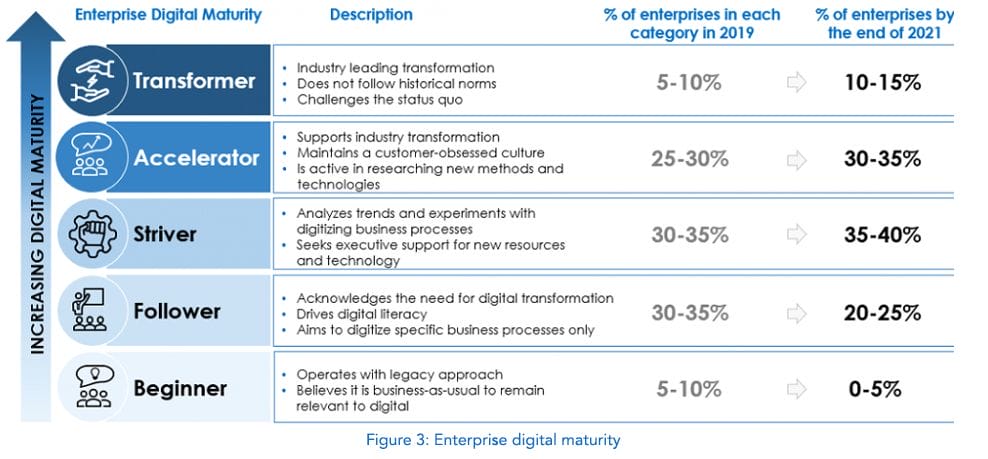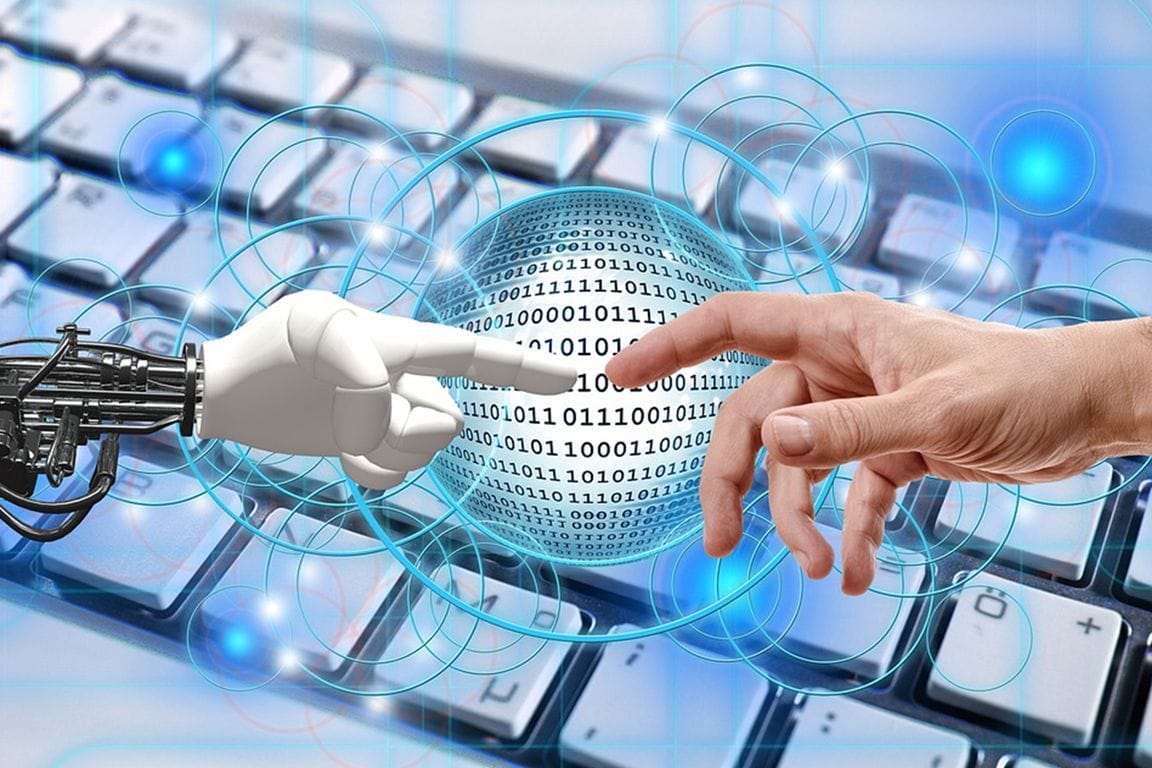Takeaways from HCL Analyst and Advisor Summit, May 19-20, 2020
The COVID-19 pandemic marks a watershed moment for companies, and the need for building digital resilience has never been greater. To address business continuity and productivity, there has been a forced shift to remote work in many organizations, along with a spike in the demand for collaboration and a sudden rush to migrate applications to the cloud.
As detailed below, HCL appears to be on the right path to take advantage of this new normal, as addressed in its recent virtual analyst and advisor summit.
Enterprises that were already on a digital transformation path and were making continuous investments in technologies including cloud, internet of things (IoT), artificial intelligence (AI), and machine learning (ML) have found themselves better prepared to navigate the current pandemic and beyond.
Avasant’s ongoing interactions with enterprise digital leaders indicate that almost all of them have taken short-term initiatives to ensure business continuity. At the same time, setting the foundation for a longer-term strategy to accelerate their move to a digital workplace will help enterprises to be prepared and well-positioned for success in the post-COVID world.
As highlighted in our recent Digital Masters 2020 RadarView™, we see organizations primarily investing in the following areas:
- Unified communications and remote working platforms
- Strategic vendor relationships
- Workplace wellness
- Omni-channel platforms
 HCL’s Mode 1-2-3 Strategy
HCL’s Mode 1-2-3 Strategy
At the recent virtual analyst and advisor summit organized by HCL on May 19 and 20th, 2020, HCL executives weaved together several of these areas to build an overall theme of “Building a Resilient Digital Enterprise.” In fact, many of its customers, including the leaders and senior executives from PepsiCo, Keurig Dr. Pepper, AkzoNobel, IHG, Merck, E.ON, and Xerox, shared their experiences on how HCL partnered with them in some of their digital initiatives.
Since assuming the CEO role in October 2016, HCL’s C Vijayakumar, has set HCL on a growth path, by articulating “Mode 1-2-3″ strategy for enabling future-proof enterprises. The three modes include the following:
- Mode 1: The existing core of enterprise businesses, which includes application services, infrastructure, engineering, and research and development (R&D) services, and business process services
- Mode 2: New growth areas which are carved out through digital initiatives and investments in technologies including cloud, IoT, and cybersecurity
- Mode 3: The ecosystems of the future, built upon products and platforms targeting specific next-generation opportunities
HCL has continued a strong focus on execution around Mode 1-2-3, coupled with key investments in the last four years. This has been evident in HCL’s 12% CAGR revenue growth from US $6.4B in 2016 to US $9.9B as on March 31, 2020. During this period, Mode 2 and Mode 3 initiatives combined grew at 35% CAGR and more than doubled HCL’s revenue in these segments.
Over the years, HCL has expanded Mode 1 services to the cloud, aligned to market demand, to help customers traverse their cloud journey. While it invested in security in the case of Mode 2 services, it strengthened its Mode 3 services by expanding its partnership with IBM and eventually acquiring a plethora of select IBM software products, including Commerce (on-premise) for omni-channel eCommerce, Connections for workstream collaboration, Portal (on-premise) for digital experience, AppScan for secure application development, and BigFix for secure device management. This is on top of driving automation, autonomics, and artificial intelligence through its homegrown DRYiCE solution.
Digital Workplace Services
HCL’s workplace strategy is based on three pillars: 1. Intuitiveness that is led by design thinking; 2. On-demand, where it leverages cloud-accelerated solutions; and 3. Personalized, where it focuses upon workforce wellness, which drives employee productivity, experience, and engagement. These three pillars are tied up with a layer of adaptive security, which offers a shift away from a traditional VPN solution to a next-gen remote access solution and a network layer to provide SD-WAN based constructs to build a cyber-resilient enterprise.
This is aligned to Avasant’s definition of a digital workplace that does not focus on devices but rather on the user’s productivity, along with the user’s experience. This is possible by offering a digital environment that integrates technologies into a single environment through email, instant messaging, video conferencing, and key business and operational applications. This is enabled through the technologies mentioned in the table below.
 Hybrid Cloud
Hybrid Cloud
HCL offers hybrid cloud services under its Mode-2 strategy, providing a set of services that spans advisory, migration, implementation, governance, security, and orchestration. It has taken an IP-centric approach and made strategic investments in developing reusable assets, including MyCloud (cloud management), ATMA (cloud migration), and iAssure (service assurance platform). In fact, it went ahead and developed verticalized cloud solutions that come with cloud-ready toolsets to address industry-specific needs. To drive the required focus and synergies, it developed three dedicated ecosystem business units launched in partnership with Google, Microsoft, and IBM in early 2020.
Multi-cloud deployments have become a standard part of enterprise IT strategy, with more and more enterprises also looking to move critical industry-specific functions to public clouds. As cloud adoption proliferates, there is an increased shift from pure infrastructure-based horizontal offerings to industry-specific cloud solutions. Major cloud providers and cloud system integrators (SIs) have already developed customized offerings for multiple industries.
Cybersecurity & GRC
HCL’s workplace strategy highlights the importance of a zero-trust-based solution, which helps plug and play any device within the corporate network. This comes along with the IoT and blockchain-based proctoring solution to authenticate user access. Security is a focus: HCL’s recent acquisition of Symantec’s enterprise consulting team adds expertise across endpoint security, web security services, cloud security, and data loss prevention. It also doubled its number of cybersecurity fusion centers, from three to six globally, which now offer a range of managed services.
This is timely, as the growing adoption of cloud services, SaaS-based solutions, BYOD, and social media-based access have expanded the threat landscape. As data is moving from the data center to the cloud, network security is no longer confined to the data center. Hence, there is a greater need for viewing network and cloud security in convergence.
Digital & Analytics
Interestingly, HCL has come out with its FENIX 2.0 framework, which helps enterprises prioritize digital investments and lays out an executable roadmap. This is achieved by plotting business processes and IT spending across a 2×2 matrix to determine differentiating and non-differentiating processes and, at the same time, assess IT spend utilized to modernize core or transform at scale. At one end of the spectrum, it’s about traditional IT spend through modernizing the core for non-differentiated processes (general ledger or HR systems, for example) while on the other end it’s about spending for digital transformation through a scaled agile approach for differentiated business processes (pricing or warehouse management for a retailer, for instance). Also, it accounts for creating zones of innovation for the processes to be reimagined through iterative and prototype approach and identify areas to scale.
To navigate the current pandemic scenario, in May 2020, HCL introduced a Virtual Digital Agile Framework to help organizations accelerate their digital transformation while working remotely.
Future State of the Digital Workplace
This future state of the digital workplace from the existing monolithic workspace can be achieved by laying out a clear roadmap that details project initiatives, capabilities, and outcome in a time-bound manner.
To conclude, enterprises across all industries will initiate tactical and strategic digital projects to increase digital maturity. As shown in the figure below, the spread will move upward as enterprises undertake newer digital projects in the post-COVID-19 era, undoubtedly leading to changes in the competitive landscape.

With all these developments, HCL appears to be well positioned in the market to manage this rush in demand owing to the following:
- Continued investments in next-gen services, including infrastructure modernization, outcome-based engineering, and ”as-a-service” integrated offerings.
- Its people-first strategy, built upon its strong leadership and a global workforce of 150,000 employees, with diverse experience and expertise to help clients reimagine their businesses.
- Investment in 11 next-gen labs to strengthen infrastructure capabilities and co-innovate with customers. These include IoT COLLAB, Cloud Native Labs, Digital Workplace Labs, and Cybersecurity Fusion Centers.
Analysis by Gaurav Dewan, Research Leader at Avasant of ‘Takeaways from HCL Analyst and Advisor Summit, May 19-20, 2020’.






